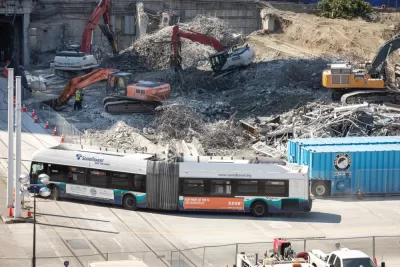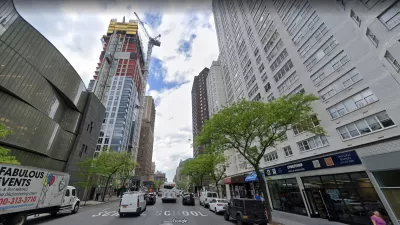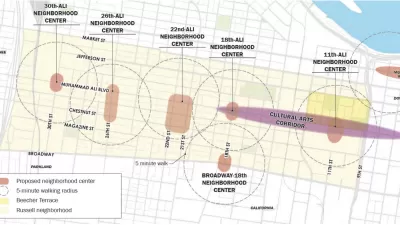Demolition can be a lot of fun for the people holding the sledge hammers and swinging the wrecking balls, but demolition is serious business with a large number of significant social and environmental consequences.

The demolition of any structure creates significant opportunities for unintended consequences and serious safety issues, both during and after the process.
As a result, there are multiple legal standards that urban planners, developers, and demolition companies must follow. They must be aware of best practices and other considerations when planning how a site's demolition and future development will be handled.
1. Dangerous Building Materials
Older structures can contain dangerous building materials like lead and asbestos, which will need to be identified and removed before demolition of a building.
When left in place, these materials can easily pose a serious health risk to both workers and residents. If a building is known or suspected to contain dangerous substances, a qualified individual should inspect the site before demolition, remediation, or cleanup of the structure.
If the inspector identifies dangerous materials, they will typically need to be removed in accordance with federal and state regulations. In Georgia, for example, only licensed asbestos abatement contractors can remove certain asbestos-containing materials, such as vinyl products.
2. Falls and Site Safety
There are some inherent dangers to demolition. Falls and struck-by hazards are two of OSHA's "fatal four" — the most common types of accidents on construction sites — and can easily cause serious injury or death.
Sites can be made safer by following all necessary and relevant safety precautions—like the OSHA demolition standards.
Preparing for falls and ensuring the use of best-practice safety measures can also help reduce the risk of injury or death. It's vital to brace ceilings and walkways, install safety nets, stock all necessary safety equipment and perform a final sweep before demolition.
3. Dust and Debris Control
Demolition produces large amounts of dust and debris. Both can be dangerous to the health of workers on-site and nearby residents, and can also damage neighboring structures.
Cities also often require that all debris is removed from the site once demolition is complete.
Controlling for dust and debris is essential in keeping structure demolition as safe as possible. Fencing, screening and shielding can control debris, while water and mulch, among other things, can control dust.
4. Plumbing Management
In many locales, structures will need to be effectively removed from the local water supply network before they can be approved for demolition.
This may require a sewer cap or the decommissioning of a septic tank. Typically, a master plumber is needed to verify that the building has been disconnected from the sewer and water supply lines.
5. The Social Impact of Demolition
Overzealous, demolition-only urban policies can have serious negative impacts on a city's residents and economy.
In residential areas, for example, vacant lots are known to drag down surrounding property values and socially isolate residents. Without a plan in place for how the lot will be developed after demolition, the process can leave the area worse off than it was before.
Demolition can also run against historic and cultural preservation efforts. In some areas, tearing down buildings in historic districts may require special permits or a notice period that can slow down the process. In New York City, for example, developers wanting to demolish buildings designated as landmarks need permission from the Landmarks Preservation Commission.
When demolishing historic structures, urban planners should consider incentives for keeping the property standing, such as the 20% tax credit for rehabilitating properties on the National Register of Historic Places. This may be more appealing to investors than a new property or vacant lot.
6. The Environmental Impact of Demolition
Vacant lots can also have significant negative environmental impacts. Typically, the soil quality and composition created by demolition prevents rainwater from soaking into the ground. As a result, these lots can produce high amounts of stormwater runoff.
This runoff usually flows toward streams and other water sources, picking up pollutants from streets, yards and sidewalks as it moves. Over time, this can negatively impact local water health and reduce sewer capacity.
With the right planning, however, these impacts can be mitigated—and vacant lots can even become an environmental positive. By preparing lots after demolition, it's possible to make the soil much more rainwater-absorbent. If the lot goes undeveloped, it will function as a storage for rainwater, reducing local runoff and straining the sewer system.
How to Ensure Demolitions Work Safely
Building demolitions can be a messy process that generates many serious knock-on effects. Poorly planned demolitions can injure site workers, cause severe environmental and social impacts, and may even cause legal trouble.
With the proper planning, it's possible to mitigate or eliminate many of these risks. Developers and planners who need to demolish a structure in the future should take these risks into consideration to ensure demolition goes as smoothly as possible.

Alabama: Trump Terminates Settlements for Black Communities Harmed By Raw Sewage
Trump deemed the landmark civil rights agreement “illegal DEI and environmental justice policy.”

Study: Maui’s Plan to Convert Vacation Rentals to Long-Term Housing Could Cause Nearly $1 Billion Economic Loss
The plan would reduce visitor accommodation by 25% resulting in 1,900 jobs lost.

Why Should We Subsidize Public Transportation?
Many public transit agencies face financial stress due to rising costs, declining fare revenue, and declining subsidies. Transit advocates must provide a strong business case for increasing public transit funding.

Paris Bike Boom Leads to Steep Drop in Air Pollution
The French city’s air quality has improved dramatically in the past 20 years, coinciding with a growth in cycling.

Why Housing Costs More to Build in California Than in Texas
Hard costs like labor and materials combined with ‘soft’ costs such as permitting make building in the San Francisco Bay Area almost three times as costly as in Texas cities.

San Diego County Sees a Rise in Urban Coyotes
San Diego County experiences a rise in urban coyotes, as sightings become prevalent throughout its urban neighbourhoods and surrounding areas.
Urban Design for Planners 1: Software Tools
This six-course series explores essential urban design concepts using open source software and equips planners with the tools they need to participate fully in the urban design process.
Planning for Universal Design
Learn the tools for implementing Universal Design in planning regulations.
Smith Gee Studio
Alamo Area Metropolitan Planning Organization
City of Santa Clarita
Institute for Housing and Urban Development Studies (IHS)
City of Grandview
Harvard GSD Executive Education
Toledo-Lucas County Plan Commissions
Salt Lake City
NYU Wagner Graduate School of Public Service






























